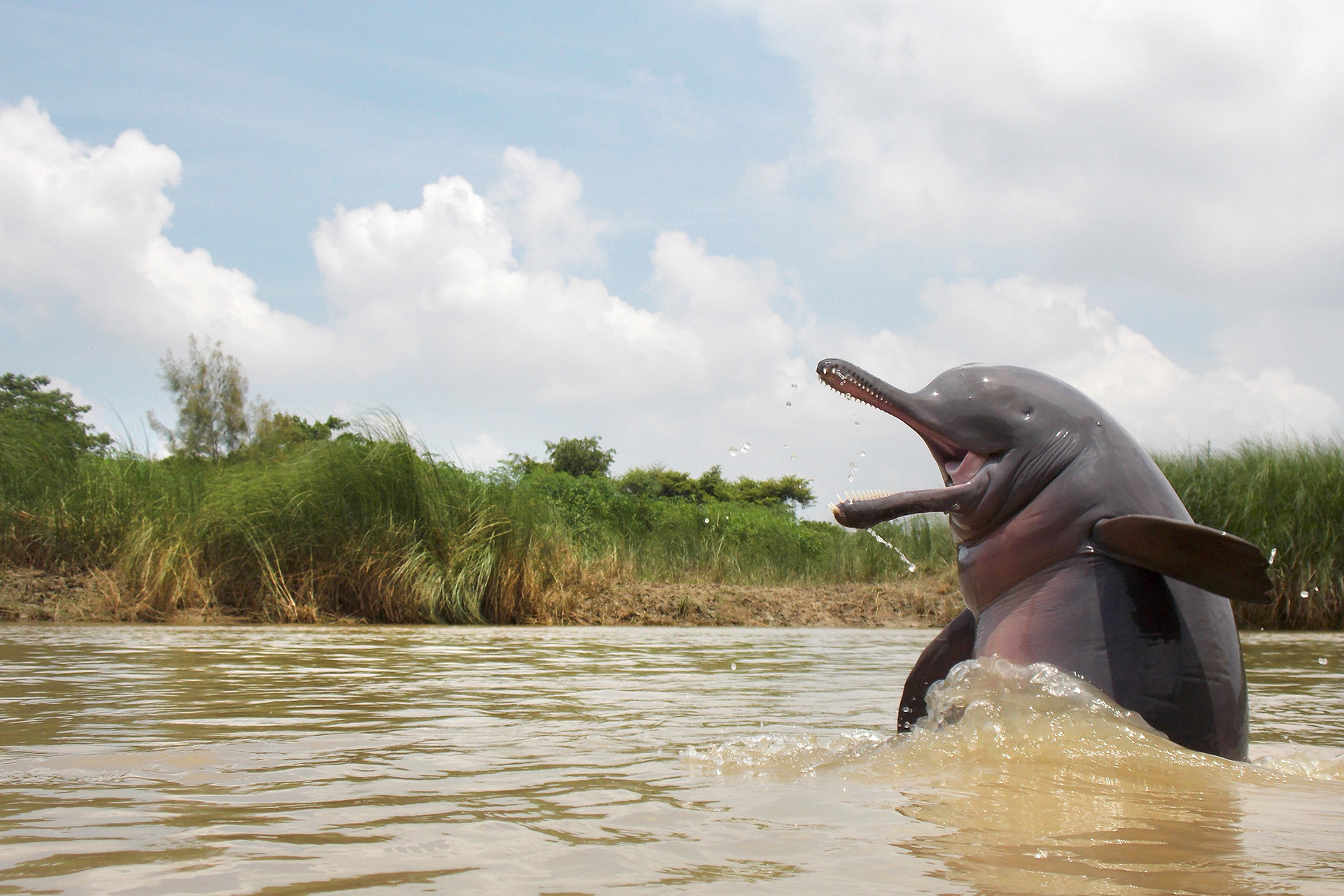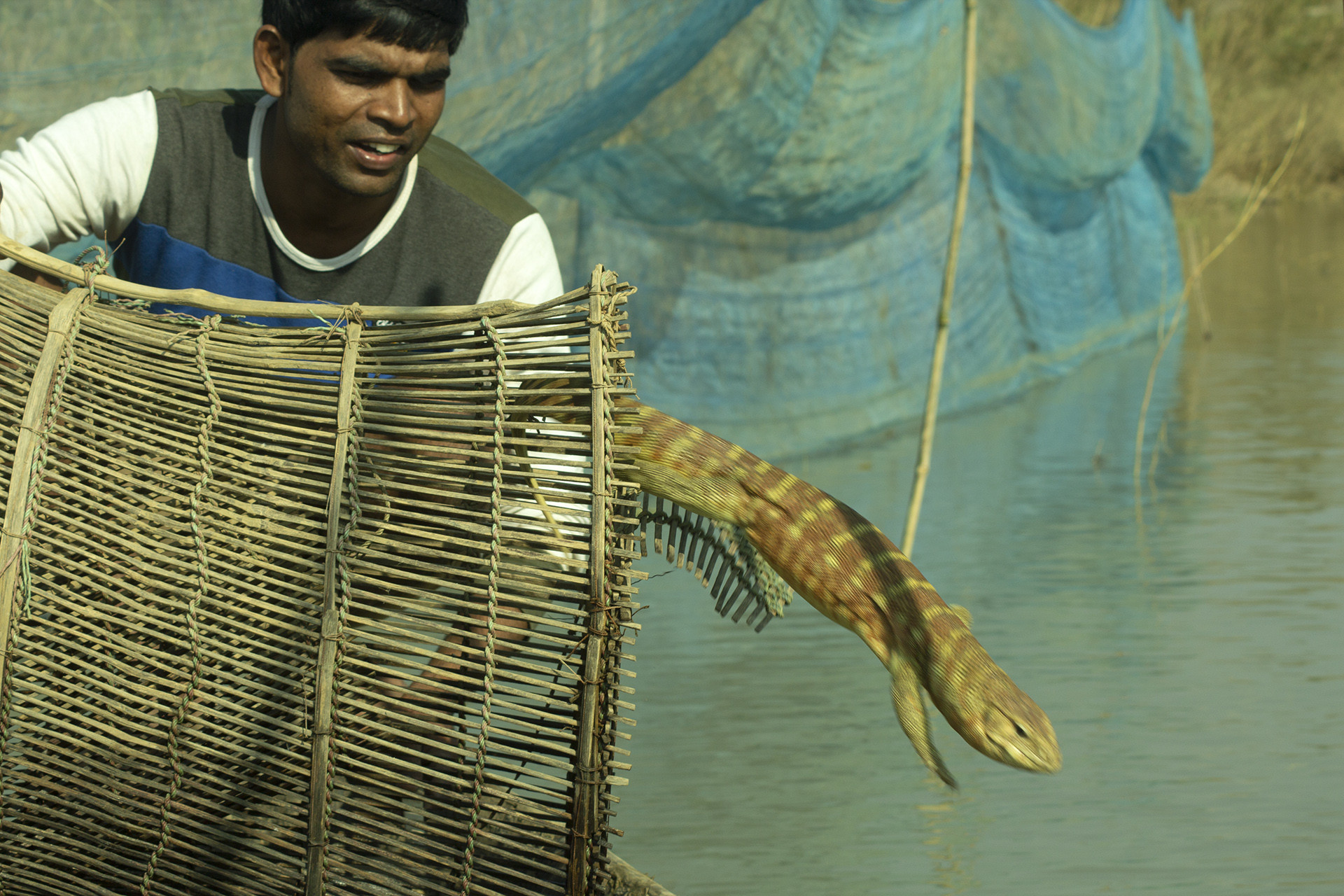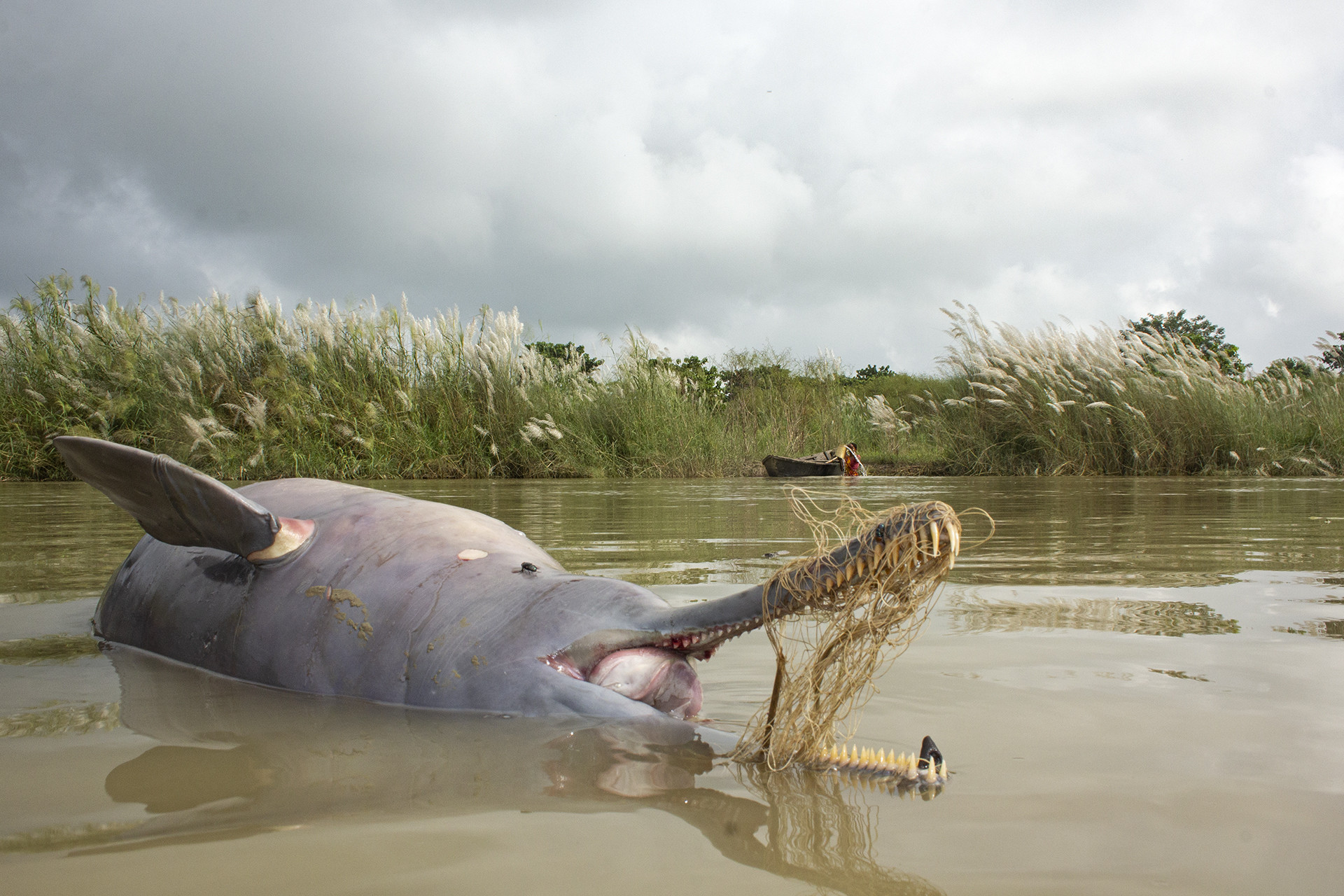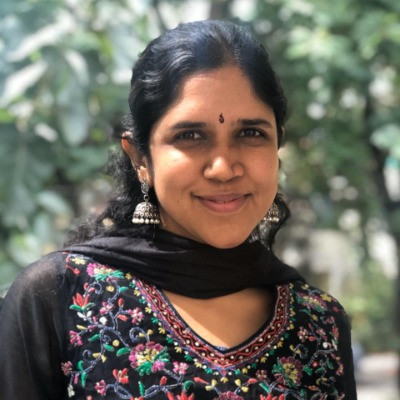Type Nayachar on Google, and you will be directed to a small island situated amidst the Hooghly River in the Medinipur district of West Bengal. The focus of a 12-year survey published by the Zoological Survey of India, Nayachar is a place known for its rich biodiversity. However, hidden from Google's prying eyes is another Nayachar – in the Nadia district – a safe haven for the endangered Ganges River Dolphin.
In 2020, the lesser-known Nayachar found itself in the news when a photographer from the region showed by example that relentless efforts often yield remarkable results. Ganesh Chowdhury’s ‘The Last Stand’ won the Animal Portraits category at the Nature inFocus Photography Awards, 2020. After a four-hour wait in the river, Chowdhury had photographed a Ganges River Dolphin emerging from the water, using a point-and-shoot camera. While talking about the image, jury member and wildlife photographer Dhritiman Mukherjee said, “I have never seen such an intimate portrait of this shy animal, featuring almost its entire body, with such an adorable expression to boot.”
It wasn’t just the endangered species tag or its adorable expression that made the image special. For many of us, this is a rare sight of a rare species, but for Chowdhury, it is a vision he has seen time and time again in Nayachar. Born and raised on the island, he has always been fond of the aquatic species. “Mujhe dolphins se itna lagav hai ke main unhe baar baar dekhne jaata hoon (I feel so connected to them that I go to see the dolphins often),” he said over a phone conversation, when I asked him about his journey to becoming a photographer and a voice for this endangered species. His enthusiasm is infectious, as he talks about the world he lives in. So infectious that you almost begin to consider leaving the humdrum of city life and moving to a place where the wilderness is at your doorstep. But before this conversation gets all Walden-esque, let me tell you that Chowdhury’s journey is not devoid of its share of struggles. As he informed me, even basic amenities like electricity have reached his village only about two years ago.
Chowdhury also won a Special Mention in the Conservation Issues category at the Nature inFocus Awards, 2020, for his portrayal of a lifeless Ganges River Dolphin tangled in a fishing net in the Ajay river. The 29-year old photographer is spearheading conservation in his own unique way, but you can hear all about that from the photographer himself. Here is a translated and edited excerpt of our conversation.
Mujhe toh vishwas hi nahi hua (I just couldn’t believe it).
Congratulations once again, Ganesh! How did it feel to win the Animal Portraits category at the Nature in Focus Photography Awards, 2020?
Honestly, when I submitted my images for the contest, I had no idea that it would amount to something. I remember calling up one of the other contestants and asking him if he had heard back about the results. I thought this is the only way I would know about the contest; when someone else wins an award. During the live event, when they announced that my image had won and I was put on the screen, I had no idea what to say. I wanted to thank the organisers for their efforts and the judges for considering my image, but I don't remember saying any of that. Kalyan [Varma] Sir is a big inspiration for me, and I wanted to say so much at the time when he congratulated me. I wish I had expressed my emotions better. But yes, I am thrilled!
Hamesha jungle mein rehta tha aur mujhe sab daant-te the. Daantne se main thodi na sunta tha (I was always in the jungle and I used to get scolded for that. But that did not mean that I listened).
Do you remember the moment when you first became aware of this world around you? What got you so interested in nature and wildlife?
When I was in the fifth or sixth standard, I became very interested in birds. But I had a strange way of expressing that interest. I would capture them and try to rear them in a cage. Many birds lost their lives in this manner, and that’s when I realised that I was wrong – even if my intentions were not to harm them. Instead, I thought I could draw them or simply observe them, and I learned a lot about birds in this manner.
I honestly don't remember playing with my friends after school. I would come back home and immediately head into the jungle to observe birds. I could not wait to spend time in the forest. The residents of my village thought that I was crazy. In fact, there were several people who told my father that maybe he should seek treatment for me as I was spending so much time in the wilderness. My father would scold me a lot, but I never listened to him. I just felt so happy there, I knew it was the right place to be.
Idhar koi birds nahi milta (You won’t find birds here).
So how did you get introduced to photography? Could you tell me a little bit about that?
Around the time I started exploring birds, I got the opportunity to interact with Tanmoy Ghosh, a wildlife photographer who used to photograph birds and animals about 40-50km from Nayachar. Tanmoy visited my village when he got to know that there were several animals and birds in this region. When I met him and he asked me about the birds in the area, I remember I lied to him that there are no birds in the area thinking that he wanted to capture them. Of course, he knew something was amiss. When I expressed my true fears, Tanmoy bhai promised me that he had no intentions of capturing them. He said he was planning to photograph them. That is when I realised that this is a great way to document birds. I expressed my interest in studying birds, and he gave me a book that helped me gain some knowledge. He encouraged me to read more. It was because of him that I began to pay attention and read about birds and animals. It was because of bhai that I learned about photography.
Un logon ke aankh mein sona rehta hai, aisi kahaniyan batate the (Their eyes are made of gold; such were the stories told by the villagers).
So first came birds then dolphins?
No, it was not like that. My father is a daily wage labourer. Sometimes he would work in fields by the river, and as a child, I would accompany him. That is how I first got to see the dolphins. My father would tell me stories about how dolphins have gold in their eyes and I remember thinking that if we capture a dolphin, we could get that gold. But my father would warn me that only a naseebwala (fortunate man) would get the gold. If the rest of us touch a dolphin, we could make it go blind. There are many such stories that the villagers share. Of course, now I know that the dolphins have extremely poor vision and use echolocation to find fish (for feeding) and to communicate. I also remember seeing dolphin calves in the shallow regions of the river. I don’t know why, but I felt so attached to them from the beginning. I remember trying to go near the calf, and the mother would appear from nowhere to protect her child. This is how they became a part of my world!
A lot of things that I have learnt, I have learnt through observation. Dolphin siblings are very protective of each other. Jo bhai hota hain na, ek saal pehle ka, maine dekha hai woh bhi apni bhai ya behan ko musibat se bachata hai aur khane mein madat karta hai (The elder dolphin sibling will always protect its brother or sister from harm and help them with finding food).
Teen din tak woh chatpata-te rahe, chatpata-te rahe, par unko koi nahi chudaya (They (dolphins) kept slapping their tails for three days, but no one came to their rescue).
When did you realise that the Ganges River Dolphins are in danger and need to be protected?
I think it was in 2012 when a dolphin pair was found trapped in a fishing net about 10km from my place. They were trapped for three days and no one had tried to set them free. When I came to know about it, I immediately left to check on them. To my utter shock, I found them dead, trapped in the fishing net. Onlookers had pelted them with stones! I had tears in my eyes. I told the people around me that this was a heinous crime. But they responded by saying that they had got scared looking at the dolphins’ teeth. I swam out to the net and cut it loose so we could release the dolphins, and then used my boat to transport them to my village. The forest department was informed immediately after that. What I realised from the incident was that people were not aware, that they had acted out of fear. I kept thinking that someone has to teach them the importance of the species, that they need to know that if we keep killing Ganges River Dolphins in this manner, woh species hi khatam ho jayegi (the species will end).
Mere paas iske liye ek strategy hai (I have a strategy for this).
How do you spread awareness about conservation in your village? Is it easy for you to reach out to them?
After that incident in 2012, I formed a team to educate my people, but I knew that I had to do it the right way. The thing is, you cannot simply talk to people about the environment and expect them to understand. They need to know why we are doing this; that their actions also impact their own livelihoods and existence. For example, I tell them that if there are dolphins or Gharials in the river, they will feed on the larger fish. But if you start killing them, the larger fish population will go unchecked and they will, in turn, start feeding on the smaller fish – the source of your livelihood. This is the kind of message that gets across.
Then, I try to talk to them about how we are destroying the environment and how we cannot let a species go extinct. I also talk to them about snakes because people would hit and kill snakes the minute they came across one. Again, I explained to them how they help keep a check on the rodent population. Now, I can confidently say that no one kills snakes here. It has taken me years and years to get their attention. At times I also play the emotional card of how they also have the right to live on this planet. Whatever gets them to pay attention, basically!
The team I have formed consists of about 11 members including Rajendra Chowdhury, Archan Mitra, Sangita Chowdhury, and Mangal Chowdhury, who help me communicate these ideas to the villagers. We also do some volunteer work for Nature Environment & Wildlife Society – a Kolkata-based NGO that works on various conservation aspects. They have helped us a lot in conducting awareness programmes and in talking to the fisherfolk of the area. As I did more and more work, some of the local schools invited me to speak to the children about conservation. Children are very perceptive and understand a lot.
Mujhe machwaro ko bachana hai aur dolphin ko bhi bachana hai (I need to save the fishers and I need to save the dolphins).
What are your future plans now that people are cooperating with you?
I want to make documentaries that educate people and teach them the importance of saving endangered species. As I said earlier, you need to tweak the message according to the audience. I would like to make a film that showcases how dolphins have families, how they communicate with each other and how we harm them by destroying their habitat and by hunting them for their oil. My intention is to create awareness so that the current and future dolphin generations are safe, and people think twice before harming them. I have recently started a homestay in the region through which I hope to involve the larger community in our conservation activities.
I would like to share a more recent incident. About five months ago, we found a dead dolphin in the river near our village. When this happens, we always take the carcass to the animal hospital to understand the reason behind the death. In this case, when the doctors cut open its stomach, they found a large ball of fishing net inside – must have been about 3.5kg in weight. We asked around, and we were told that this kind of fishing net was in use about 8-10 years ago, which means it was probably abandoned in the water, and when the dolphin attempted to feed on the fish trapped inside, it also consumed the net. (Researchers in Cyprus have also reported that when food options are scarce, dolphins in the region have broken nets to access the fish.) I think it is vital that we also create opportunities for fishers when we talk about creating a better ecosystem for the animals. We need a balanced approach, and I hope to work on that if given the opportunity. I am worried that if I don't act soon, all the dolphins in Nayachar will be gone.
Koi animals hamein buri nazar se nahi dekhte (Animals don’t intend to harm us).
What is your message for the people who live outside your village?
I don’t know where you are. Some of you may be in Delhi, some in Rajasthan, some in Mumbai. I cannot expect you to come to Nayachar and help save the dolphins. But what I would request you to do is to support the people who are working at the frontline of wildlife conservation in your region. So many people move away from this line of work as there is a lack of financial support. We need to find ways to incentivise the process. That is what we are hoping to achieve through our homestay, provide financial support and help increase awareness.
My second request to you is to try and allocate some of your time for the environment, even if it is for just half an hour, say to clean the plastic waste in your area. Whatever you can do to make a difference, you must try and do that. Last and most important, please respect all animals and try not to hurt them. They don't want to hurt you either.







